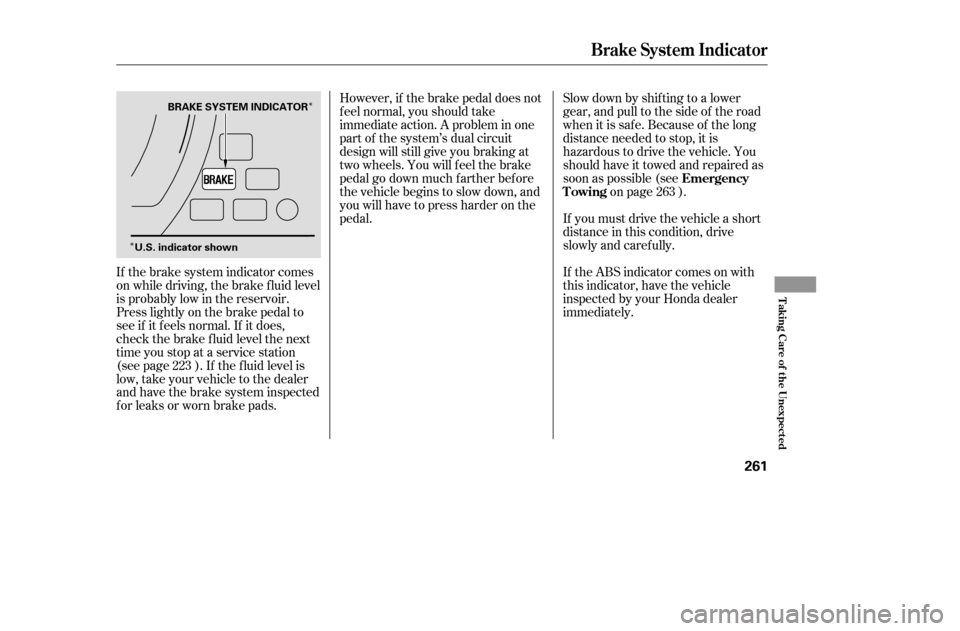Page 232 of 289

When installing cables, f ollow the
manuf acturer’s instructions, and
mount them as tight as you can.
Make sure they are not contacting
the brake lines or suspension. Drive
slowly with them installed. If you
hear them coming into contact with
the body or chassis, stop and
investigate. Remove them as soon as
youbegindrivingonclearedroads.
Cable-types: SCC Radial Chain
CH2311T or SCC SC Cable SC1030
Link-type: SCC Quick Grip QG1134
Cable-types: SCC Radial Chain
CH2311T or SCC SC Cable SC1030
Link-type: SCC Quick Grip QG1130
Cable-types: SCC Radial Chain
CH2311T or SCC SC Cable SC1030
Because your vehicle has limited tire
clearance, Honda strongly
recommends using the chains listed
below, made by Security Chain
Company (SCC).
Mount snow chains on your tires
when required by driving conditions
or local laws. Install them only on the
f ront tires.
EX and V6
LX
DX
Tires
T ire Chains
Maint enance
241
Using the wrong chains, or not
properly installing chains, can
damage the brake lines and
cause a crash in which you can
be seriously injured or killed.
Follow all instructions in this
owner’s manual regarding the
selection and use of tire chains.
�����—�����—�����y�
�������������y���
�(�����������y���������y
Page 235 of 289

Leave the parking brake off. Put
the transmission in Reverse
(5-speed manual) or Park
(automatic).
Block the rear wheels.
If the vehicle is to be stored f or a
longer period, it should be
supported on jackstands so the
tires are of f the ground.
Leave one window open slightly (if
the vehicle is being stored
indoors).
Disconnect the battery.Support the f ront wiper blade
arms with a f olded towel or rag so
they do not touch the windshield.
To minimize sticking, apply a
silicone spray lubricant to all door
and trunk seals. Also, apply a
vehiclebodywaxtothepainted
surfaces that mate with the door
and trunk seals.
Cover the vehicle with a
‘‘breathable’’ cover, one made
f rom a porous material such as
cotton. Non-porous materials, such
as plastic sheeting, trap moisture,
which can damage the paint.
If possible, periodically run the
engine until it reaches f ull
operating temperature (the
cooling f an cycles twice).
Pref erably, do this once a month.
Vehicle Storage
244
�����—�����—�����y�
�������������y���
�(�����������y���������y
If you store your vehicle f or 1 year or
longer, have your dealer perf orm the
you take it ou
t of storage (see
pages 202and 204 ). The 6-cylinder
model needs the inspections called
f or in the 2 years/ 30,000 miles
(48,000 km) maintenance schedule
(Normal Conditions) and the 4-
cylinder model needs the inspections
called f or in the 2 years/40,000 miles
(64,000 km) maintenance schedule
(Normal Conditions). The
replacements called f or in the
maintenance schedule are not
needed unless the vehicle has actually
reached that time or mileage.
maintenance inspections as soon as
Page 237 of 289

CONT INUED
Park the vehicle on f irm, level and
non-slippery ground. Put the
transmission in Park (automatic)
or Reverse (manual). Apply the
parking brake.The tools are in the trunk. Open
the trunk and raise the trunk f loor
by lif ting up on the back edge.
Turn on the hazard warning lights,
and turn the ignition switch to
LOCK (0). Have all the
passengers get out of the vehicle
while you change the tire. Take the tool kit out of the trunk.
Unscrew the wing bolt and take
the spare tire out of its well.
If you have a f lat tire while driving,
stop in a saf e place to change it.
Drive slowly along the shoulder until
you get to an exit or an area that is
far away from the traffic lanes.
5.
4.
3.
2. 1.
Changing a Flat T ire
T aking Care of t he Unexpect ed
247
TRUNK FLOOR
SPARE TIRE JACK
TOOL KIT
The vehicle can easily roll off
the jack, seriously injuring
anyone underneath.
Follow the directions for
changing a tire exactly, and
never get under the vehicle
when it is supported only by thejack.
�����—�����—�����y�
�����������
�y���
�(�����������y���������y
Page 239 of 289
CONT INUED
Bef ore mounting the spare tire,
wipe any dirt of f the mounting
surface of the wheel and hub with
a clean cloth. Wipe the hub
carefully;itmaybehotfrom
driving.
Remove the wheel nuts and f lat
tire. Place the f lat tire on the
ground with the outside surf ace of
the wheel f acing up.
Do not attempt to forcibly pry the
wheel cover of f with a screwdriver
or other tool. The wheel cover
cannot be removed without f irst
removing the wheel nuts.
Use the extension and the wheel
nut wrench as shown to raise the
vehicle until the f lat tire is of f the
ground.
10.
12.
11.
U.S. DX, LX and DX, LX-G model in
Canada:
Changing a Flat T ire
T aking Care of t he Unexpect ed
249
WHEEL WRENCH
EXTENSION
BRAKE HUB
�����—�����—�����y�
�������������y���
�(�����������y���������y
Page 243 of 289

Open the hood, and check the
physical condition of the battery.
In very cold weather, check the
condition of the electrolyte. If it
seems slushy or f rozen, do not try
jump starting until it thaws.
To jump start your vehicle:
You cannot start your vehicle by
pushing or pulling it. The numbers in the illustration show
the order to connect the jumper
cable.
1.
CONT INUED
Jump St art ing
T aking Care of t he Unexpect ed
253
BOOSTER
BATTERY
4-cylinder models
A battery can explode if you do
not follow the correct procedure,
seriously injuring anyonenearby.
Keep all sparks, open flames,
and smoking materials away
from the battery. If a battery sits in extreme
cold, the electrolyte inside can f reeze.
Attempting to jump start with a f rozen
battery can cause it to rupture.
�����—�����—�����y�
�����������
�y���
�(�����������y���������y
Although this seems like a simple
procedure, you should take several
precautions.
2.Turn of f all the electrical acces-
sories: heater, A/C, climate
control, stereo system, lights, etc.
Put the transmission in Neutral
(M/T) or Park (A/T), and set the
parking brake.
Page 246 of 289

Saf ely pull to the side of the road.
Put the transmission in Neutral or
Park, and set the parking brake.
Turn of f all accessories, and turn
on the hazard warning indicators.
If you see steam and/or spray
coming f rom under the hood, turn
of f the engine. Wait until you see
no more signs of steam or spray,
then open the hood.If you do not see steam or spray,
leave the engine running, and
watch the temperature gauge. If
the high heat is due to overloading,
the engine should start to cool
down almost immediately. If it
does, wait until the temperature
gauge comes down to the midpoint,
then continue driving.
If the temperature gauge stays at
the red mark, turn of f the engine.
Look f or any obvious coolant leaks,
such as a split radiator hose.
Everything is still extremely hot,
so use caution. If you f ind a leak, it
must be repaired bef ore you
continue driving (see
on page ).
The pointer of the vehicle’s
temperature gauge should stay in
the midrange. If it climbs to the red
mark, you should determine the
reason (hot day, driving up a steep
hill, etc.).
If your vehicle overheats, you should
take immediate action. The only
indication may be the temperature
gauge climbing to or above the red
mark. Or you may see steam or
spray coming f rom under the hood.
1. 2.3. 4. 5.
263Emergency
Towing
If theEngineOverheats
256
Steam and spray from an
overheated engine can
seriously scald you.
Do not open the hood if steam
is coming out.
Driving with the temperature
gauge pointer at the red mark can
cause serious damage to your engine.
�����—�����—�����y�
�������������y���
�(�����������y���������y
Page 251 of 289

�Î
�ÎHowever, if the brake pedal does not
f eel normal, you should take
immediate action. A problem in one
part of the system’s dual circuit
design will still give you braking at
two wheels. You will f eel the brake
pedal go down much f arther bef ore
the vehicle begins to slow down, and
you will have to press harder on the
pedal. If the ABS indicator comes on with
this indicator, have the vehicle
inspected by your Honda dealer
immediately.
If the brake system indicator comes
on while driving, the brake f luid level
is probably low in the reservoir.
Press lightly on the brake pedal to
see if it f eels normal. If it does,
check the brake f luid level the next
time you stop at a service station
(see page ). If the f luid level is
low, take your vehicle to the dealer
and have the brake system inspected
for leaks or worn brake pads. If you must drive the vehicle a short
distance in this condition, drive
slowly and caref ully.
Slow down by shif ting to a lower
gear, and pull to the side of the road
when it is saf e. Because of the long
distance needed to stop, it is
hazardous to drive the vehicle. You
should have it towed and repaired as
soon as possible (see
on page ).
223 263
Emergency
Towing
Brake System Indicator
T aking Care of t he Unexpect ed
261
BRAKE SYSTEM INDICATOR
U.S. indicator shown
�����—�����—�����y�
�������������y���
�(�����������y���������y
Page 253 of 289

�µ�µ
If your vehicle needs to be towed,
call a prof essional towing service or
an organization. Never tow your
vehicle with just a rope or chain. It is
very dangerous.
Therearetwowaystotowyour
vehicle.
The operator
loads your vehicle on the back of a
truck.
The tow
truck uses two pivoting arms that go
under the tires (f ront or rear) and lif t
them of f the ground. The other two
tires remain on the ground. If , due to damage, your vehicle must
be towed with the f ront wheels on
the ground, do the f ollowing:
Release the parking brake.
Shif t the transmission to Neutral.
Release the parking brake.
Start the engine.
ShifttoD,thentoN.
Turn of f the engine.
Manual Transmission
Automatic Transmission:
CONT INUED
Emergency T owing
Flat -bed Equipment
Wheel-lif t Equipment
This is the best way to trans-
port your vehicle.
T his is
an acceptable way to tow your
vehicle.
T aking Care of t he Unexpect ed
263
Improper towing preparation will
damage the transmission. Follow the
above procedure exactly. If you cannot
shif t the transmission or start the
engine (automatic transmission), your
vehicle must be transported with the
f ront wheels of f the ground.
�����—�����—�����y�
�������������y���
�(�����������y���������y